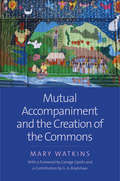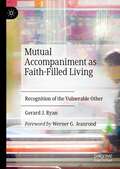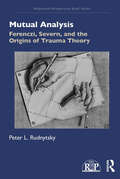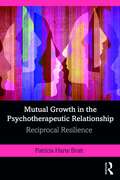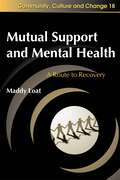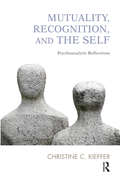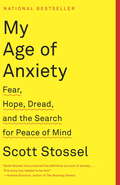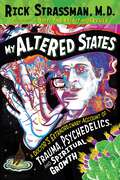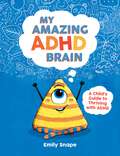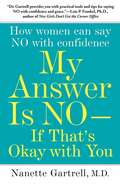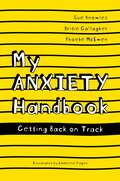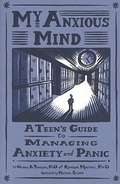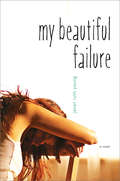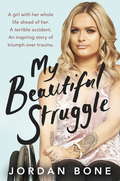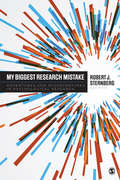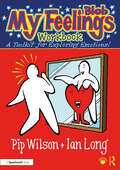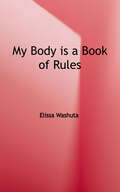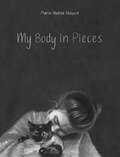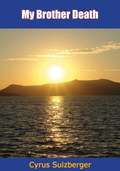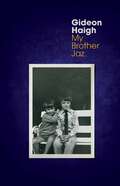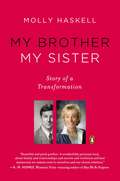- Table View
- List View
Mutual Accompaniment and the Creation of the Commons
by Mary WatkinsA landmark book that maps a radical model not only for the “helping” professions but for the work of solidarity This timely and pathbreaking volume maps a radical model of accompaniment, exploring its profound implications for solidarity. Psychosocial and ecological accompaniment is a mode of responsive assistance that combines psychosocial understanding with political and cultural action. Accompaniment—grounded in horizontality, interdependence, and potential mutuality—moves away from hierarchical and unidirectional helping-profession approaches that decontextualize suffering. Watkins envisions a powerful paradigm of mutual solidarity with profound implications for creating commons in the face of societal division and indifference to suffering.
Mutual Accompaniment as Faith-Filled Living: Recognition of the Vulnerable Other
by Gerard J. RyanIn this book, Gerard J. Ryan examines the interrelationship between recognition theory and theology with their respective concerns for what it means to be a human. He advocates a mutual accompaniment that reformulates recognition theory within a practical and public theology. Ryan develops this interpersonal recognition through the accompaniment of vulnerable people, particularly persons with disabilities and those who suffer from mental illness. He explores three contexts that support this mutual accompaniment and the labour of recognition. These are narrativity, the stories we live out of; vulnerability, the basic human condition common to all; and participation, the inter-relationship of humanity.
Mutual Analysis: Ferenczi, Severn, and the Origins of Trauma Theory (Relational Perspectives Book Series)
by Peter L. RudnytskySándor Ferenczi’s mutual analysis with Elizabeth Severn—the patient known as R.N. in the Clinical Diary—is one of the most controversial and consequential episodes in the history of psychoanalysis. In his latest groundbreaking work, Peter L. Rudnytsky draws on a trove of archival sources to provide a definitive scholarly account of this experiment, which constitutes a paradigm for relational psychoanalysis, as Freud’s self-analysis does for classical psychoanalysis. In Part 1, Rudnytsky tells the story of Severn’s life and traces the unfolding of her ideas, culminating in The Discovery of the Self. He shows how her book contains disguised case histories not only of Ferenczi and Severn herself—and thereby forms an indispensable companion volume to Ferenczi’s Clinical Diary—but also of Severn’s daughter Margaret, an internationally acclaimed dancer whose history of childhood sexual abuse uncannily replicated Severn’s own. Part 2 compares Severn to Clara Thompson and Izette de Forest as transmitters of Ferenczi’s legacy, sets the record straight about Ferenczi’s final illness, and reveals how Severn went beyond Freud and Groddeck in her capacity as Ferenczi’s analyst. Finally, in Part 3, Rudnytsky delineates the contrast between Freud and Ferenczi as men and thinkers and makes it clear why he agrees with Erich Fromm that Ferenczi’s example demonstrates how Freud’s attitude need not be that of all analysts. The first comprehensive study of Ferenczi’s mutual analysis with Severn, this book is a profound reexamination of Ferenczi’s relationship to Freud and an impassioned defense of Severn and Ferenczi’s views on the nature and treatment of trauma. It will appeal to psychoanalysts and psychotherapists, especially to relational analysts, self psychologists, and trauma theorists.
Mutual Growth in the Psychotherapeutic Relationship: Reciprocal Resilience
by Patricia Harte BrattMutual Growth in the Psychotherapeutic Relationship: Reciprocal Resilience is an essential, innovative guide for mental health professionals who listen repeatedly to stories of devastation and trauma. Moving beyond traditions that consider the clinician as existing only for the patient and not as an individual, this breakthrough model explores the possibility of mutual resilience-building and personal benefit developing between therapists and their patients. The first section of the book situates Reciprocal Resilience in the context of evolving resilience studies. The second section provides lively, demonstrative clinical anecdotes from therapists themselves, organized into chapters focused on enhancing their positive strategies for coping and growth while functioning under duress. This book presents a framework for teaching and supervising psychotherapists that can enrich clinician well-being, while recognizing the therapeutic relationship as the key for enabling patients’ emotional growth. It challenges mental health practitioners to share their own experiences, presenting a research model syntonic with how clinicians think and work daily in their professional practice. It offers a pioneering approach, finding inspiration in even the darkest moments for therapists and patients alike.
Mutual Support and Mental Health: A Route to Recovery
by Maddy LoatWhen dealing with mental health problems it is often difficult to find people who can empathise and this may lead to feelings of isolation and discouragement. The therapeutic potential of meeting others who are facing similar mental health issues is therefore invaluable. By sharing experiences and supporting one another sufferers can help alleviate distress and enable psychological well-being to be prioritised. The book provides an overview of mutual support and its benefits, such as the provision of opportunities for the validation and normalisation of experiences and the self worth that will be gained from the practice of advising and supporting others. The book includes practical application of mutual support theory backed up by evidence of the positive impact it has had on a variety of groups. The author provides an evaluation of the current provision of mutual support within mental health services and offers clear advice on how to access or facilitate this type of support. This accessible book combines theory with practice to provide both mental health professionals and those experiencing mental health difficulties with essential information on mutual support and the positive impact it can have on people's lives.
Mutuality, Recognition, and the Self: Psychoanalytic Reflections
by Christine C. KiefferThis book examines emerging trends in contemporary psychoanalytic theory and practice, highlighting inter-subjective and relational models of the mind. The author presents vivid and extended clinical vignettes that demonstrate the analyst's use of the self in building clinical momentum and continued development. The author highlights the importance of mutuality and recognition in the development of the self, illustrating the impact of family, the larger group context, and the contribution of the analytic encounter. This book is divided into three sections: First, the contribution of family to development, including some relatively neglected topics, such as the importance of fathers in female development, the role of siblings, the experience of 'only' children or singletons in the family, and the impact of the extended family (including grandparents) upon the individual. A second section examines the influence of unconscious group processes upon individual development and functioning, and includes papers that highlight the contribution of group psychotherapy as a form of treatment.
My Age of Anxiety: Fear, Hope, Dread, and the Search for Peace of Mind
by Scott StosselA riveting, revelatory, and moving account of the author's struggles with anxiety, and of the history of efforts by scientists, philosophers, and writers to understand the condition <P><P>As recently as thirty-five years ago, anxiety did not exist as a diagnostic category. Today, it is the most common form of officially classified mental illness. Scott Stossel gracefully guides us across the terrain of an affliction that is pervasive yet too often misunderstood. Drawing on his own long-standing battle with anxiety, Stossel presents an astonishing history, at once intimate and authoritative, of the efforts to understand the condition from medical, cultural, philosophical, and experiential perspectives. <P><P>He ranges from the earliest medical reports of Galen and Hippocrates, through later observations by Robert Burton and Søren Kierkegaard, to the investigations by great nineteenth-century scientists, such as Charles Darwin, William James, and Sigmund Freud, as they began to explore its sources and causes, to the latest research by neuroscientists and geneticists. <P><P>Stossel reports on famous individuals who struggled with anxiety, as well as on the afflicted generations of his own family. His portrait of anxiety reveals not only the emotion's myriad manifestations and the anguish anxiety produces but also the countless psychotherapies, medications, and other (often outlandish) treatments that have been developed to counteract it. <P><P> Stossel vividly depicts anxiety's human toll--its crippling impact, its devastating power to paralyze--while at the same time exploring how those who suffer from it find ways to manage and control it. My Age of Anxiety is learned and empathetic, humorous and inspirational, offering the reader great insight into the biological, cultural, and environmental factors that contribute to the affliction.
My Altered States: A Doctor's Extraordinary Account of Trauma, Psychedelics, and Spiritual Growth
by Rick Strassman&“Every reader will find this account fascinating. A lively and intensely personal addition to the drugs-memoir genre.&”—Kirkus Reviews&“You're such an important part of the psychedelic history.&”—Joe Rogan Experience, episode #1854• Recounts several dozen of the author&’s experiences of drug and non-drug altered states of consciousness from birth to early adulthood• Applies the lenses of four explanatory models—psychoanalysis, psychopharmacology, Zen Buddhism, and medieval Jewish metaphysics—in understanding how and why they occurred• Demonstrates the importance of careful unflinching recollection and documentation of both heavenly and hellish altered states in one&’s psychological, emotional, and spiritual lifeWhy do we seek out altered states of consciousness, or why, in some cases, do they happen unbidden? What do we see and hear, and what happens emotionally, physically, and psychologically? How and why are these experiences different from or similar to one another? Are they meaningful? And what do we do with them after they have passed?Addressing these questions, renowned psychedelic researcher Rick Strassman, M.D., draws upon his journals and analyses of dozens of episodes of altered consciousness that occurred during, or are intimately tied to, his life between birth and young adulthood. Just as significant as the ecstatic blissful experiences are the uncensored and, at times, painfully unvarnished narratives of less elevated ones. Visually augmenting all these accounts are the striking images of artist Merrilee Challiss.Understanding and applying the meaning and message of any altered state—its integration—first requires a clear-eyed recollection of the actual experience in all its aspects, neither pushing away the ugly nor grasping after the beautiful. This book provides a profound example of how one might go about accomplishing this daunting task.
My Amazing ADHD Brain: A Child's Guide to Thriving with ADHD
by Emily SnapePip is a confident little monster who has ADHD. In this book, they share what that means for them and how it has some really brilliant benefits.My Amazing ADHD Brain is packed with reassuring words, practical advice and skill-building activity ideas, and has a fun, relatable voice.
My Answer is No . . . If That's Okay with You: How Women Can Say No and (Still) Feel Good About It
by Nanette GartrellAre you afraid you'll hurt the people you care about if you say NO to them? Can you set limits when employees neglect their responsibilities? How about with your boss? When friends ask you to do something you don't want to do, do you invent an elaborate excuse? Do you have a hard time saying NO to an invitation even when you're completely exhausted? Do you have trouble even practicing the sentence "No, Mom, I just can't make it home this holiday"? If any of these scenarios sound familiar, keep reading - you need this book... No is a very simple word -- two letters, one syllable. Yet many women have a hard time saying it without feeling anxious or guilty. In My Answer Is NO...If That's Okay with You, award-winning psychiatrist and author Dr. Nanette Gartrell takes a fresh look at why even the most powerful, accomplished, and successful women find it difficult to say no and offers a revolutionary approach to setting limits without jeopardizing important relationships. Today women are bombarded with messages like "put yourself first" and "stop being a people-pleaser." But this sort of advice is useless to women who value the caring and generosity that prompt them to say yes in the first place. Through personal interviews with a diverse group of talented women, including CEOs, celebrities, physicians, and public officials, Dr. Gartrell shows that women's reluctance to say no stems from valuable traits that they should embrace, such as empathy, sensitivity, and thoughtfulness. With humor and wisdom, Dr. Gartrell reaffirms the psychological importance of compassion and feeling connected, which can often lead a woman to say yes rather than no in order to preserve a relationship or spare someone's feelings. Through entertaining anecdotes and insights from her years of clinical practice, Dr. Gartrell teaches women to honor their best instincts while still maintaining boundaries. My Answer Is NO...If That's Okay with You offers creative, practical ways to transform an automatic or reluctant yes into a healthy, respectful no -- and still feel good about it.
My Anxiety Handbook: Getting Back on Track
by Sue Knowles Bridie Gallagher Phoebe McEwen Emmeline PidgenHelping young people with anxiety learn to recognise and manage their symptoms, this anxiety survival guide teaches 12 to 18 year olds how they can overcome their biggest worries. Showing that anxiety is a normal human emotion that many people face, this book helps young people understand the ins and outs of their own anxiety and helps them to challenge the difficult patterns they may get into. Co-written with a college student who has experienced anxiety herself, it is a relatable and straightforward guide. As well as providing tried-and-tested advice and exercises that are proven to reduce feelings of anxiety, it includes recovery stories from young people who have managed their symptoms successfully. With practical chapters on sleep, exam stress, transitions, and seeking extra help, this is a go-to guide for any tween, teen or young person living with anxiety.
My Anxious Mind: A Teen's Guide to Managing Anxiety and Panic
by Michael A. Tompkins Katherine A. MartinezWritten for teens who are experiencing anxiety and panic attacks, this guide provides simple strategies and tools that can reduce these feelings and behaviors in roughly 30 minutes. Tompkins and Martinez are both licensed psychologists and practitioners at a San Francisco center for cognitive therapy, and they provide concise and effective tips that include breathing and relaxation exercises, nutrition, sleep, exercise and facing fears "one step at a time." Additional chapters deal with knowing when to ask for help, and when medication may be a viable option for dealing with these stressful situations.
My Beautiful Failure
by Janet Ruth YoungBilly is a sophomore in high school, and twice a week, he volunteers at Listeners, a suicide hotline. Jenney is an "incoming," a caller, a girl on the brink. As her life spirals out of control, Jenney's calls become more desperate, more frequent. Billy, struggling with the deteriorating relationship with his depressed father, is the only one who understands. Through her pain, he sees hope. Through her tears, he feels her heart. And through her despair, he finds love. But is that enough? Acclaimed author Janet Ruth Young has written a stunning and powerful story with no easy answers; it is about pain and heartbreak, reality and illusion, and finding redemption and the strength to forgive in the darkest of times.
My Beautiful Struggle
by Jordan BoneA girl with her whole life ahead of her. A terrible accident. An inspiring story of triumph over trauma. Aged 15, Jordan was a happy-go-lucky girl; having fun with friends and loving life. In one fateful moment, everything changed. A car accident left her paralysed from the chest down and shocked her into deep depression. She was on the brink of giving up. But gradually Jordan realised there is hope beyond utter devastation, and life beyond disability.Painstakingly re-learning how to apply her beloved make-up, Jordan began to rebuild her sense of self and empowerment. Her body may have been broken but her spirit was not. She is now a successful beauty blogger and her journey of positivity inspires millions around the world.MY BEAUTIFUL STRUGGLE is the incredible true story of how one young woman overcame immense challenges, of inner strength that lies beneath outer beauty, of how to believe in yourself and find the light when it feels like all hope is gone.
My Beautiful Struggle
by Jordan Bone<P>Aged 15, Jordan Bone got into a car with friends. She would never walk again. Paralysed from the chest down, her life was changed forever. Becoming depressed and feeling like life wasn't worth living, these weren't the teenage years that Jordan had envisaged. <P>However, slowly but surely, she began to get herself out of the darkness. With a little help from the internet, Jordan started to embrace positive thinking and embarked on a personal journey to get her confidence - and her life - back. Eleven years on from the accident, Jordan creates her own beauty tutorials on YouTube and has a range of successful brand partnerships. She has reclaimed her life and her independence and now wants to share her inspirational story with others and is telling it through different aspects of beauty. This isn't a book about looking good on the surface, this is a story of inner strength, believing in yourself and finding motivation when you feel like all hope is gone.
My Biggest Research Mistake: Adventures and Misadventures in Psychological Research
by Robert J. SternbergMy Biggest Research Mistake helps students and professionals in the field of psychological science learn from the diverse mistakes of successful psychological scientists. Through 57 personal stories drawn from the experiences of fellows in the Association for Psychological Science (APS), editor Robert J. Sternberg presents the mistakes of experts in the field as opportunities for learning, allowing students to avoid making the same mistakes in their own work.
My Biggest Research Mistake: Adventures and Misadventures in Psychological Research
by Robert J. SternbergMy Biggest Research Mistake helps students and professionals in the field of psychological science learn from the diverse mistakes of successful psychological scientists. Through 57 personal stories drawn from the experiences of fellows in the Association for Psychological Science (APS), editor Robert J. Sternberg presents the mistakes of experts in the field as opportunities for learning, allowing students to avoid making the same mistakes in their own work.
My Blob Feelings Workbook: A Toolkit for Exploring Emotions! (Blobs)
by Pip Wilson Ian LongMy Blob Feelings Workbook provides the reader with a series of unique visual reflective exercises that help to reveal one’s own emotional portrait. Using a combination of Blob characters and open questions, the reader can gradually build up an image of themselves across a wide range of ‘who I am’ subjects and real-life scenarios. Packed with well-loved blob illustrations, this book includes a wealth of downloadable pages and will enable the individual to ‘draw’ a picture of themselves emotionally through the series of exercises. Sections covered include: • My Charts • My Feeling Scales • My Scenarios • Myself Scales Best used as a personal toolkit for self-awareness, this book is also a rich resource for professionals working in the field of feelings to use with their own clients. It is suitable for all ages from secondary school upwards and ideal for individuals, couples, groups and all who wish to go deeper in understanding their emotional strengths and areas for development.
My Blob Feelings Workbook: A Toolkit for Exploring Emotions! (Blobs)
by Pip Wilson Ian LongMy Blob Feelings Workbook provides the reader with a series of unique visual reflective exercises that help to reveal one’s own emotional portrait. Using a combination of Blob characters and open questions, the reader can gradually build up an image of themselves across a wide range of ‘who I am’ subjects and real-life scenarios.Packed with well-loved blob illustrations, this book includes a wealth of downloadable pages and will enable the individual to ‘draw’ a picture of themselves emotionally through the series of exercises. Sections covered include: My Charts My Feeling Scales My Scenarios Myself Scales Best used as a personal toolkit for self-awareness, this book is also a rich resource for professionals working in the field of feelings to use with their own clients. It is suitable for all ages from secondary school upwards and ideal for individuals, couples, groups and all who wish to go deeper in understanding their emotional strengths and areas for development.
My Body Is a Book of Rules
by Elissa Washuta"A candid, autobiographical scrapbook from a young woman navigating manic depression....A fever dream of darkly personal memories and musings from the shadowy corners of sexual violence and mental illness." <p><p>As Elissa Washuta makes the transition from college kid to independent adult, she finds herself overwhelmed by the calamities piling up in her brain. When her mood-stabilizing medications aren't threatening her life, they're shoving her from depression to mania and back in the space of an hour. Her crisis of American Indian identity bleeds into other areas of self-doubt; mental illness, sexual trauma, ethnic identity, and independence become intertwined. Sifting through the scraps of her past in seventeen formally inventive chapters, Washuta aligns the strictures of her Catholic school education with Cosmopolitan's mandates for womanhood, views memories through the distorting lens of Law & Order: Special Victims Unit, and contrasts her bipolar highs and lows with those of Britney Spears and Kurt Cobain. <p><p>Built on the bones of fundamental identity questions as contorted by a distressed brain, My Body Is a Book of Rules pulls no punches in its self-deprecating and ferocious look at human fallibility. This debut memoir from the independent publisher Red Hen Press isn't for the faint of heart. Washuta's honest and lyrical language as well as her subject matter—her struggles with bipolar disorder and coping with the effects of rape—will gut you, but it's the rawness of this work that makes it worth reading. Washuta's form, including revised psychiatrists' notes, annotated research papers on the use of the term "hooking up," summaries of prescription medications, and a Match.com profile, is inventive and invites the reader into the author's chaotic brain. The book perfectly articulates the difficulties navigating the path toward adulthood while coping with trauma and mental illness.
My Body in Pieces
by Marie-Noëlle HébertA deeply emotional graphic memoir of a young woman’s struggles with self-esteem and body image issues.All Marie-Noëlle wants is to be thin and beautiful. She wishes that her thighs were slimmer, that her stomach lay flatter. Maybe then her parents wouldn’t make fun of her eating habits at family dinners, the girls at school wouldn’t call her ugly, and the boy she likes would ask her out. This all-too-relatable memoir follows Marie-Noëlle from childhood to her twenties, as she navigates what it means to be born into a body that doesn’t fall within society’s beauty standards.When, as a young teen, Marie-Noëlle begins a fitness regime in an effort to change her body, her obsession with her weight and size only grows and she begins having suicidal thoughts. Fortunately for Marie-Noëlle, a friend points her in the direction of therapy, and slowly, she begins to realize that she doesn’t need the approval of others to feel whole.Marie-Noëlle Hébert’s debut graphic memoir is visually stunning and drawn entirely in graphite pencil, depicting a deeply personal and emotional journey that encourages us to all be ourselves without apology. Key Text Featuresgraphic novelcomic style
My Brother Death (Death And Dying Ser.)
by Cyrus SulzbergerThis remarkable book by the distinguished journalist Cyrus Sulzberger is in a modern sense comparable to Burton’s famous The Anatomy of Melancholy.My Brother Death is a thoughtful and finely written effort to discern just what death is, to define both it and its relationship to man, to discuss how to meet its inevitable approach and what may lie beyond.To accomplish this purpose Mr. Sulzberger draws heavily from the history of human thought and experience, from all the principal religions of East and West; from the philosophers, saints, kings and heroes who one by one have crossed to the unknown.He documents and dramatizes the entire panorama of the ways in which men die: by acts curiously attributed to the God of disaster, pestilence, famine and illness; by man’s own hand in murder, war, cannibalism, capital punishment and religious persecution.How does death approach and how and why do the brave best prepare to meet it? Not only does the author introduce the reader to the reflections of outstanding men upon their final des tiny; he himself has spent many years contemplating this problem which is everyone’s secret concern. He has personally investigated death on many battlefields and on all seven continents of this earth.By these investigations and by his own deep study of history, philosophy and the dimly remembered customs of our atavistic past, he has assembled a fascinating and, in a sense, comforting picture of human courage, a courage that triumphs over human evil.This sad but lovely tale of eternity and our own role in its embrace begins appropriately on a happy little Greek island. It ends there, aeons later, among “the soft Aegean waters that bear me northward and backward into time.”
My Brother Jaz
by Gideon HaighIn January 2024, in a period of personal crisis, Gideon Haigh abruptly started writing the story of the night his seventeen-year-old brother Jasper was killed, finally facing how it had shaped the rest of his life. Seventy-two hours later he stopped. Dark, raw and revealing, My Brother Jaz is how it feels to lose someone, and yourself, even as the rest of the world turns, and you struggle to keep up.
My Brother My Sister
by Molly HaskellA feminist film critic’s thoughtful, outspoken memoir about transgender and family On a visit to New York, the brother of well-known film critic Molly Haskell dropped a bombshell: Nearing age sixty, and married, he had decided to become a woman. In the vein of Jan Morris’s classic Conundrum and Jennifer Finney Boylan's She's Not There, a transgender memoir, Haskell’s My Brother My Sister gracefully explores a delicate subject, this time from the perspective of a family member. Haskell chronicles her brother Chevey’s transformation through a series of psychological evaluations, grueling surgeries, drug regimens, and comportment and fashion lessons as he becomes Ellen. Despite Haskell’s liberal views on gender roles, she was dumbfounded by her brother’s decision. With candor and compassion, she charts not only her brother’s journey to becoming her sister, but also her own path from shock, confusion, embarrassment, and devastation to acceptance, empathy, and love. Haskell widens the lens on her brother’s story to include scientific and psychoanalytic views. In an honest, informed voice, she has revealed the controversial world of gender reassignment and transsexuals from both a personal and a social perspective in this frank and moving memoir. .
My Brother My Sister
by Molly HaskellA feminist film critic's thoughtful, outspoken memoir about transgender and family On a visit to New York, the brother of well-known film critic Molly Haskell dropped a bombshell: Nearing age sixty, and married, he had decided to undergo sugery to become a woman. In the vein of Jan Morris's classic Conundrum and Jennifer Finney Boylan's She's Not There, a transgender memoir, Haskell's My Brother My Sister gracefully explores a delicate subject, this time from the perspective of a family member. Haskell chronicles her brother Chevey's transformation through a series of psychological evaluations, grueling surgeries, drug regimens, and comportment and fashion lessons as he becomes Ellen. Despite Haskell's liberal views on gender roles, she was dumbfounded by her brother's decision. With candor and compassion, she charts not only her brother's journey to becoming her sister, but also her own path from shock, confusion, embarrassment, and devastation to acceptance, empathy, and the pleasure of having a sister. Haskell widens the lens on her brother's story to include scientific and psychoanalytic views. In an honest, informed voice, she has revealed the controversial world of gender reassignment and transsexuals from both a personal and a social perspective in this frank and moving memoir.
